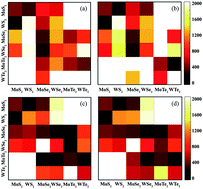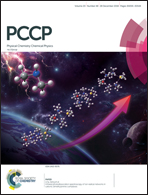The role of Anderson’s rule in determining electronic, optical and transport properties of transition metal dichalcogenide heterostructures†
Abstract
Two-dimensional (2D) transition metal dichalcogenides (TMDs) MX2 (M = Mo, W; X = S, Se, Te) possess unique properties and novel applications in optoelectronics, valleytronics and quantum computation. In this work, we performed first-principles calculations to investigate the electronic, optical and transport properties of the van der Waals (vdW) stacked MX2 heterostructures formed by two individual MX2 monolayers. We found that the so-called Anderson's rule can effectively classify the band structures of heterostructures into three types: straddling, staggered and broken gap. The broken gap is gapless, while the other two types possess direct (straddling, staggered) or indirect (staggered) band gaps. The indirect band gaps are formed by the relatively higher energy level of Te-d orbitals or the interlayer couplings of M or X atoms. For a large part of the formed MX2 heterostructures, the conduction band maximum (CBM) and valence band minimum (VBM) reside in two separate monolayers, thus the electron–hole pairs are spatially separated, which may lead to bound excitons with extended lifetimes. The carrier mobilities, which depend on three competitive factors, i.e. elastic modulus, effective mass and deformation potential constant, show larger values for electrons of MX2 heterostructures compared to their constituent monolayers. Finally, the calculated optical properties reveal strong absorption in the ultraviolet region.



 Please wait while we load your content...
Please wait while we load your content...